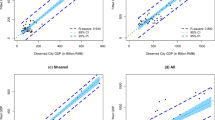Abstract
This article analyses socioeconomic flows and social stocks using governmental statistics data on both air transportation and demographic and economic censuses from a holistic point of view. The network analysis of the Japanese air transportation network consists of 86 domestic airports with 476 connections. Betweenness centrality and PageRank are computed for the network structure. Furthermore, a relationship between socioeconomic flows (passengers and freight) and social stocks (population, the number of workers and the number of firms) is investigated based on governmental statistics data. To determine the relationship, a gravity model, which proposes that a socioeconomic flow between two places is proportional to a power-law relationship among social stocks around the places and their geodesic distance, is assumed. Parameters with the relationship for passengers and freight are estimated, and an adequate radius distance to compute social stocks around Japanese airports is determined. This result can be used to infer socioeconomic flows from social stocks.







Similar content being viewed by others
References
Barthélemy M (2010) Spatial networks. Phys Rep 499:1–101
Bettencourt LMA, Lobo J, Helbing D, Kühnert C, West GB (2007) Growth, innovation, scaling, and the pace of life in cities. Proc Natl Acad Sci USA 104:7301–7306
Brin S, Page L (1998) The anatomy of a large-scale hypertextual Web search engine. Comput Netw ISDN Syst 30:107–117
Brockmann D, Helbing D (2013) The hidden geometry of complex, network-driven contagion phenomena. Science 342:1337–1342
Cha A, McCleary KW, Uysal M (1995) Travel motivations of Japanese overseas travelers: a factor-cluster segmentation approach. J Travel Res 34:33–39
Eriander S, Stewart NF (1990) The gravity model in transportation analysis: theory and extensions. VSP, Zeist
Expert P, Evans TS, Blondel VD, Lambiotte R (2011) Uncovering space-independent communities in spatial networks. Proc Natl Acad Sci USA 108:7663–7668
Freeman LC (1977) A set of measures of centrality based on betweenness. Sociometry 40:35–41
Guimerà R, Amaral LAN (2004) Modeling the world-wide airport network. Eur Phys J B 38:381–385
Haag G, Weidlich W (1984) A stochastic theory of interregional migration. Geogr Anal 16:331–357
Isard W (1975) A simple rationale for gravity model type behavior. Papers Reg Sci Assoc 35:25–30
Japanese Air transportation statistics of the Ministry of Land, Infrastructure, Transport and Tourism in Japan (2011). http://www.mlit.go.jp/k-toukei/search/excel/11/11201100a00004.xls. Accessed 10 May 2013
Jung W-S, Wang F, Stanley HE (2008) Gravity model in the Korean highway. Europhys Lett 81:48005
Mikkonen K, Luoma M (1999) The parameters of the gravity model are changing—how and why? J Transp Geogr 7:277–283
Pöyhönen PA (1963) A tentative model for the volume of trade between countries. Weltwirtschaftliches Arch 90:93–100
Rodrigue J-P, Comtois C, Slack B (2009) The geography of transport systems. Routledge, London
Simini F, González MC, Maritan A, Barabási A-L (2012) A universal model for mobility and migration patterns. Nature 484:96–100
Sivrikaya O, Tunç E (2013) Demand forecasting for domestic air transportation Turkey. Open Transp J 7:20–26
Statistics Bureau of the Ministry of International Affairs and Communications in Japan (2014). http://www.e-stat.go.jp/SG1/estat/toukeiChiri.do?method=init Accessed 5 June 2014
Woolley-Meza O, Thiemann C, Grady D, Lee JJ, Seebens H, Blasius B, Brockmann D (2011) Complexity in human transportation networks: a comparative analysis of worldwide air transportation and global cargo-ship movements. Eur Phys J B 84:589–600
Zhang J, Yu T (2010) Allometric scaling of countries. Physica A 389:4887–4896
Zipf GK (1946) The P1/P2/D hypothesis: on the intercity movement of persons. Am Soc Rev 11:677–686
Acknowledgments
This work is partially supported by a Grants-in-Aid for Scientific Research (KAKENHI) (C) (#25390152). This research used the computational resources of the HPCI system provided by (Institute of Statistical Mathematics) through the HPCI System Research Project (Project ID:hp140076).
Author information
Authors and Affiliations
Corresponding author
Ethics declarations
Conflict of interest
On behalf of all authors, the corresponding author states that there is no conflict of interest.
Appendix: Statistics data on Japanese 86 airports
Appendix: Statistics data on Japanese 86 airports
See Table 6.
About this article
Cite this article
Sato, AH., Sawai, H. Relationship between socioeconomic flows and social stocks: case study on Japanese air transportation. Evolut Inst Econ Rev 12, 243–263 (2015). https://doi.org/10.1007/s40844-015-0016-z
Published:
Issue Date:
DOI: https://doi.org/10.1007/s40844-015-0016-z
Keywords
- Governmental statistics data
- Air transportation statistics
- Population census
- Economic census
- Gravity model
- Multiple regression analysis




